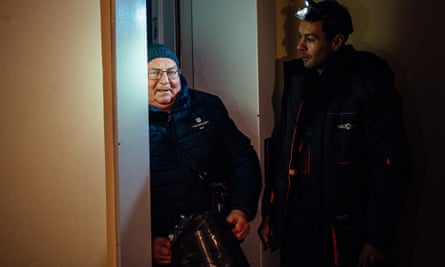Markus Peuser was in the lift up to his 10th-floor apartment when one of Russia’s early drone barrages against Kyiv hit a power station, and the small metal box shuddered to a halt.
It was at least a good time to get trapped, he said wryly. “I was coming from the supermarket, so I had enough food with me and a bottle of wine,” he said. By the time someone came to rescue him, two hours later, he’d got through “a lot of chocolates”.
Attacks on Ukraine’s civilian infrastructure including its power stations intensified this autumn, after major battlefield losses for the Russian army.
Drones and missiles have caused death and destruction in civilian areas across the country, and left millions without electricity, water or heating for long periods.
They have also turned mundane parts of daily life into an obstacle course. Few things have become as fraught as getting into an elevator, with the risk of being trapped in a tiny enclosed space for hours if the power goes out.

“I still use them, but it feels something like stepping into a James Bond movie every time,” said Peuser, a German who owns a language school in Kyiv. He evacuated when Russia invaded in February, but came back in May to the city he calls home.
Three months after he got stuck with his shopping, the private language school he runs with his Ukrainian business partner Viktoria Gorokhovska has helped stock 5,000 emergency boxes for Kyiv lifts.
They contain food, water, wipes and, in a nod to the horror many people share of being trapped in a small confined space, packets of tranquillisers.
Some in Ukraine now avoid elevators entirely, including Gorokhovska, who said she could just take the stairs in the low-rise buildings where she lives and works.
But like most modern cities, Kyiv is dotted with high-rise buildings, and not everyone has the fitness or patience to trek up and down many floors on foot. Others have health issues that make even a few flights of stairs a challenge.
One pregnant woman went into labour while trapped in an elevator in November, although authorities got her out in time to give birth in hospital.
Tetiana and Vlad Konovalov moved house because they struggled to look after their 20kg puppy in a 20th-floor apartment, once power cuts shut the lift off regularly.
Cirilla, a bouncy eight-month-old golden retriever, needs to go out at least four times a day. Vets had warned that regularly walking – or running – down 20 flights of stairs could ruin her joints, so every time the power went out, Vlad had to carry her.
When the power was on, using the lifts was still a gamble because they worried how the playful young dog would deal with being trapped.

They had already lost one home when they moved from heavily bombed eastern Kharkiv to Kyiv, but this month they decided to forfeit their deposit on that apartment and move into the relative comfort of a ninth-floor flat.
“We lost money,” said Tetiana, watching Cirilla play near a miniature Big Ben in their “New England” apartment complex. “But our health and our dog’s health was more important.”
For those who do not have an option to move, the emergency boxes could prove a vital lifeline.
Peuser and Gorokhovska started an initiative to create 100 for the buildings of employees and friends in the early autumn.
Then two big companies offered to provide supplies, and city authorities agreed to arrange delivery, so the team at StartDeutsche school turned the school into a packaging centre.
Their boxes – and others – have gone viral on social media. One TikTok video shows a girl explaining the box. As she does the power goes out, the lift stops and she screams.
Posts such as this have led to Gorokhovska getting requests from distant parts of the country, and she is now coordinating the packaging of 3,000 boxes for the southern river port city of Dnipro.
There have been few reported thefts, perhaps because of the shared threat. “People said it would be stolen or broken open within days,” she said.
“But in Ukraine now we understand this is something everyone might need. If you take it home today, tomorrow you might be the one stuck without it.”

Leave a Reply